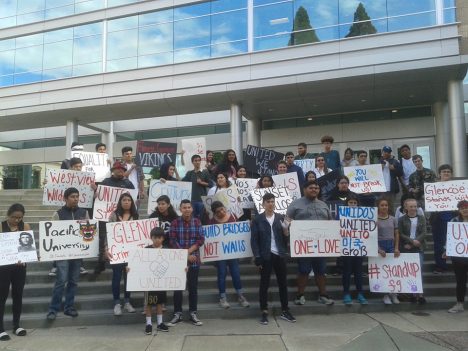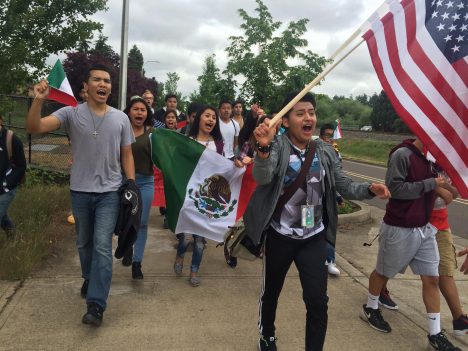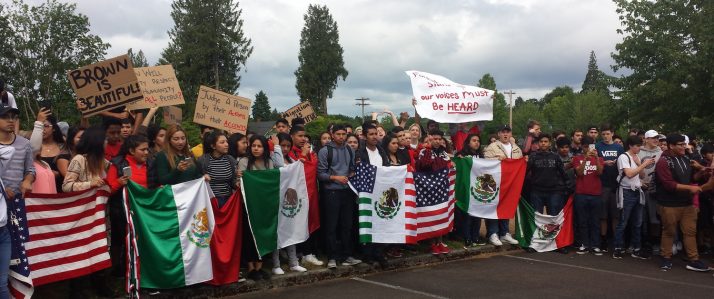In mid May, Latinx youth, allies, and community groups from Forest Grove and surrounding communities confronted racism rooted in the rhetoric of building a wall on the US-Mexico border.
The racial tensions that have been present in the community for some time were elevated during a key “unity week” event at Forest Grove High School when two students posted a “Build the Wall” banner in the school halls. The message to many Latinx youth, who make up 50% of the student body population, was clear: you and your family are not welcome. For many students, this is an all too familiar message that perpetuates feeling marginalized and unwelcomed due to a lived reality that overt racism and institutional racism continues to exist. It’s this unchecked and unresolved institutional racism pushing students to march in solidarity in Portland, and now Woodburn. The youth have a shared experience that is not contained in one community, but many.
We as philanthropic leaders, donors, and allies can’t ignore the important action taken by youth throughout the region and the data that corroborates the students’ narrative of institutional racism. Just look at the disproportionate discipline data, graduation rates, and reading and math scores of Latinx students, compared to their white peers. These inequities don’t event include challenges faced when trying to find work opportunities post-high school and college.
Students are challenging US, we who have become complacent to the slow progress of racial justice and equity, to confront the old pillars of a school system meant to support a white homogenous student body that perpetuates racial disparities. Students are asking for an end to detention, increased access to ESOL classes, equal access to college information and counselors, and a more inclusive school curriculum that considers ethnic studies.
Similar calls to action come from members of the Black Lives Matter movement, Don’t Shoot, Hoodies for Trayvon, and college students asking us to confront institutional racism at our local law enforcement agencies and college campuses. Each of these movements has stumbled upon a sobering truth: Institutional racism must be confronted, no matter how uncomfortable it makes us or others feel.
What are we to do as funders, donors, and allies? How do we respond within our own communities, many of which are being paralyzed by indifference and doubt? These students are challenging us to confront racism at the institutional and individual level by requiring us to lean in, listen, and ultimately act. We have much influence and collectively, we have power and we are being given an opportunity to use this power to partner with the student leaders.
 First, we must accept the experiences of the students. Second, and most challenging, we must value the solutions that the youth present. This may be the most difficult of steps for us who live in a culture that values solutions coming from the administrative level or through paid consultants. The suggestion is not to drop the use of “experts” but rather to recognize that students are experts in their own right. Third, and most importantly, we need to support and nurture the leadership of youth who have the audacity to find solutions. Many of us in the funding world do this work already, but this moment calls on us to rise to the occasion to strategically fund a once-in-a-generation movement that is at the cusp of realization.
First, we must accept the experiences of the students. Second, and most challenging, we must value the solutions that the youth present. This may be the most difficult of steps for us who live in a culture that values solutions coming from the administrative level or through paid consultants. The suggestion is not to drop the use of “experts” but rather to recognize that students are experts in their own right. Third, and most importantly, we need to support and nurture the leadership of youth who have the audacity to find solutions. Many of us in the funding world do this work already, but this moment calls on us to rise to the occasion to strategically fund a once-in-a-generation movement that is at the cusp of realization.
MRG Foundation is dedicated to lean in, listen, act, and build bridges where needed. We challenge funders, supporters, and allies to lean in with us.
Photo Credits: 95.9 FM Radio Movimiento and Kristinoel Ludwig





